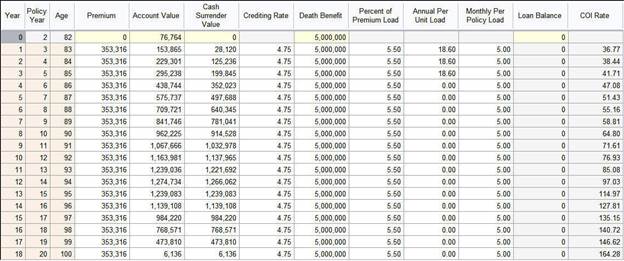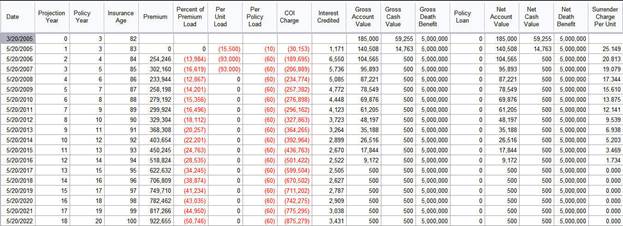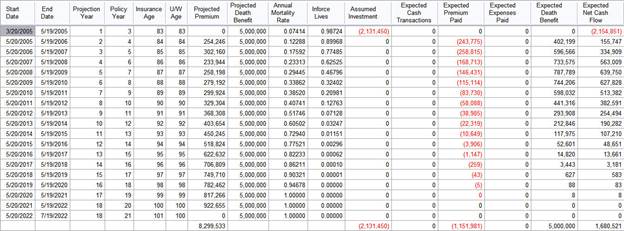Life Settlement Valuation Overview
The industry standard policy valuation approach is called the probabilistic method (as opposed to
deterministic or stochastic).
The term probabilistic refers to
the survivorship curve (probabilities of survival) with which future cash flows
are weighted.
present value as opposed to an accountant’s present value which would discount
the cash flows with interest only. We’re including a measure of the likelihood that the insured survives to each future
year of age.
Step 1 - Reverse Engineer COI Rates

COI rates can be calculated from a standard Policy Illustration. Most
illustrations contain enough information that the COI rates can be determined.
It is important that any valuation model accommodate most common UL policy features
so that the COI rates may be calculated with the greatest possible accuracy:
- Death Benefit Options
- Level
- Increasing
- Return of Premium
- Extended Death
Benefit
- Required
Annual Premium
- Policy Loads
and Fees
It is not likely that any model
will be able to properly value policies with secondary guarantee provisions
since the details of the UL fund accumulation are disclosed by the carrier.
These contracts can often be analyzed as non-UL contracts (Premium and Death
Benefit Only), so any valuation model should support non-UL product types in
addition to UL products.
Step 2 - Project Optimum Premium

After obtaining the COI rates, future projected premiums may be calculated. The
goal is to determine the minimum (optimal) funding premium which keeps the contract
inforce without overfunding the contract.
Some desirable features of a valuation model include:
- There should be some facility to
roll the account value forward from the date of the last known account value to
the projection start date. Without this, it will be necessary to obtain the policy
account value as of the projection start date either from an external calculation,
or by contacting the carrier
(impractical).
- The model should provide various
threshold options so that the analyst can dial in the level of future premium
paid based on the amount of target account value is desired in each future year
of the contract.
- Similarly, the analyst should be able to specify various patterns of future
premium payments – monthly, quarterly, etc. It is also desirable to be able to
input a custom stream of premium payments for the first few years before allowing
the model to optimize the remaining premiums (more control over the analysis).
Step 3 - Develop Survivorship Curve
Most of the variability in pricing results from the sensitivity of the analysis
to changes in mortality (expected longevity). It is critical when analyzing a single
case to perform sensitivity testing – i.e., to be able to stress the survivorship curve
to generate a range of possible outcomes.
Important features of a valuation model include:
- Ability to model multiple LE
estimates in one run.
- Ability to apply mortality
improvement and to otherwise reshape the mortality curve by applying adjustment
factors by age and duration.
It is increasingly important to
be able to work directly with the vector of lives supplied by some LE
underwriters as part of their LE report since this vector effectively provides
the analyst with the mortality table used by the underwriter and sometimes
significantly affects the analysis.
Step 4 - Calculate Valuation

Important features of a valuation model include:
- The model should generate a range
of values based on various Life Expectancy estimates and assumed discount
rates.
- Should be able to model the
organization’s expense structure if appropriate.
- The model should produce a complete
set of valuation cash flows – expected premium, death benefits and expected
survivorship curve.
Portfolio Considerations
Stochastic analysis is necessary to
assess the range of possible portfolio outcomes.
Critical to anyone investing in a
portfolio of life settlement contracts.
Valuation model should integrate well with portfolio analytics. At a
minimum, it should be possible to pass optimized premium, death benefit and
survivorship vectors to the portfolio tool from the valuation model.
Other descriptive fields such as Carrier, Diagnosis, State of Issue, etc.
are also of interest to assess concentration of risk in the portfolio.
A record of actual purchase price and premiums paid is necessary to calculate
portfolio IRR’s. Model should be able to incorporate known payments with future
projected payments to arrive at projected IRR.